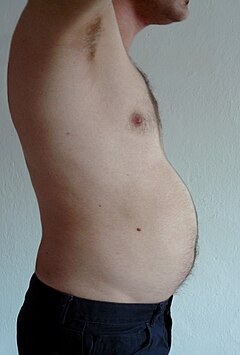Adipose tissue/ja: Difference between revisions
Created page with "(ChIP-seq)]は、DNA上のタンパク質結合部位を同定し、[[histone/ja|ヒストン修飾を評価するために用いられる手法である。このツールにより、褐変のエピジェネティック制御の研究が可能になり、タンパク質-DNA相互作用がベージュ脂肪細胞の分化を刺激するメカニズムの解明に役立っている。ベージュ脂肪細胞のクロマチンラン..." |
Created page with "===遺伝学=== {{Main/ja|Genetics of obesity/ja#Genes}} 倹約遺伝子仮説(飢饉仮説とも呼ばれる)は、ある種の集団では、身体は豊富な時に脂肪を保持する効率が高く、それによって食糧不足の時に飢餓に対する抵抗力が高まるというものである。この仮説は、もともとはグルコース代謝とインスリン抵抗性の文脈で提唱されたが、その文脈に..." |
||
| Line 136: | Line 136: | ||
</div> | </div> | ||
===遺伝学=== | |||
== | {{Main/ja|Genetics of obesity/ja#Genes}} | ||
{{Main|Genetics of obesity#Genes}} | [[thrifty gene hypothesis/ja|倹約遺伝子仮説]](飢饉仮説とも呼ばれる)は、ある種の集団では、身体は豊富な時に脂肪を保持する効率が高く、それによって食糧不足の時に飢餓に対する抵抗力が高まるというものである。この仮説は、もともとはグルコース代謝とインスリン抵抗性の文脈で提唱されたが、その文脈に関しては、身体人類学者、生理学者、そして[[:en:James V. Neel|この考えの最初の提唱者]]自身によって否定されている。しかし、開発者によれば、他のコンテクストでは「最初に開発されたときと同じように実行可能」なのだという。 | ||
<div lang="en" dir="ltr" class="mw-content-ltr"> | <div lang="en" dir="ltr" class="mw-content-ltr"> | ||
Revision as of 07:30, 28 February 2024
| 脂肪組織 | |
|---|---|
 豚の腹の脂肪(白) | |
 脂肪組織は結合組織の主な種類の一つである。 | |
| Pronunciation | /ˈædɪˌpoʊs/ ( |
| Anatomical terminology | |
脂肪組織(体脂肪または単に脂肪とも呼ばれる)は、主に脂肪細胞から構成される緩い結合組織である。また、前脂肪細胞、線維芽細胞、血管内皮細胞や脂肪組織マクロファージなどの様々な免疫細胞の細胞の間質血管分画(SVF)も含んでいる。主な役割は脂質の形でエネルギーを貯蔵することであるが、クッションや保温も行っている。
以前はホルモンに不活性な臓器として扱われていたが、近年、脂肪組織はレプチン、エストロゲン、レジスチン、サイトカイン(特にTNFα)などのホルモンを産生するため、主要な内分泌臓器として認識されている。肥満では、脂肪組織はアディポカインとして知られる炎症性マーカーの慢性的な放出に関与しており、メタボリックシンドローム—(2型糖尿病、心血管系疾患、アテローム性動脈硬化症を含む一連の疾患の発症に関与している。
脂肪組織は前駆脂肪細胞に由来し、その形成は部分的に脂肪遺伝子によって制御されているようである。脂肪組織には、エネルギーを貯蔵する白色脂肪組織(WAT)と、体温を発生させる褐色脂肪組織(BAT)の2種類がある。脂肪組織—、特に褐色脂肪組織—は、1551年にスイスの博物学者コンラッド・ゲスナーによって初めて同定された。
解剖学的特徴

人間には脂肪組織がある:皮膚の下(皮下脂肪)、内部の臓器の周囲(内臓脂肪)、骨髄(黄色骨髄)、筋肉間(筋肉系)、乳房(乳腺組織)に存在する。脂肪組織は特定の場所に存在し、それらは脂肪デポと呼ばれている。脂肪組織内の細胞の中で最も高い割合を占める脂肪細胞以外に、間質血管分画(SVF)と総称される他のタイプの細胞も存在する。SVFには前脂肪細胞、線維芽細胞、脂肪組織マクロファージ、内皮細胞が含まれる。
脂肪組織は多くの小さな血管を含んでいる。皮膚を含む表皮系では、最深部である皮下層に蓄積し、熱や寒さからの断熱を提供する。 臓器の周囲では、保護パッドを提供している。しかし、その主な機能は脂質の備蓄であり、身体のエネルギー需要を満たすために酸化することができ、肝臓が糖質から生成したトリグリセリドを貯蔵することによって過剰なグルコースから身体を保護することであるが、糖質からの脂質合成のほとんどが脂肪組織自体で起こることを示唆する証拠もある。体のさまざまな部位にある脂肪組織は、生化学的プロフィールが異なっている。正常な状態では、脂肪組織は空腹と食事に関するフィードバックを脳に与える。
マウス

マウスには8つの主要な脂肪腺があり、そのうち4つは腹腔内にある。一対の生殖腺脂肪床はメスでは子宮と卵巣、オスでは精巣上体と精巣に付着している。一対の後腹膜脂肪床は腹部の背側壁に沿って存在し、腎臓を取り囲んでおり、巨大になると骨盤にまで及ぶ。 腸間膜は腸と卵膜(胃と脾臓の近くで発生する)を支える糊のような網を形成し、 -巨大になると -腹部まで伸びる。 腸間膜および卵膜の両デポには、それぞれリンパ節および乳白色斑として多くのリンパ組織が取り込まれている。
この2つの表在性脂肪層は、後肢の上肢節の前方(皮膚の下)にある一対の鼠径部脂肪層と、肩甲骨の背稜間の皮膚の下にある、白色脂肪組織の領域に隣接する褐色脂肪組織の内側にある一対の肩甲下脂肪層である。 このデポの褐色脂肪組織の層は、しばしば白色脂肪組織の「すりガラス」で覆われている;これらの2つのタイプの脂肪(褐色と白色)の区別が難しいこともある。 鼠径リンパ節は鼠径リンパ節群を包んでいる。 マイナーデポには、心臓を包む心膜と、膝の後ろの主要な筋肉の間にある一対の膝窩デポがあり、それぞれに大きなリンパ節が1つずつある。 マウスのすべてのデポの中で、生殖腺デポは最も大きく、最も容易に剥離可能であり、剥離可能な脂肪の約30%を占める。
肥満
肥満者において、腹部から下方に垂れ下がる余分な脂肪組織はパンニクルスと呼ばれる。パンニクルスは病的肥満者の手術を複雑にする。重度の肥満者が大量の脂肪を失った場合(胃バイパス手術の一般的な結果)、文字通り「皮膚のエプロン」として残ることがある。 肥満は、運動療法、食事療法、行動療法によって治療される。再建手術は治療の一側面である。
内臓脂肪===

内臓脂肪または腹部脂肪(臓器脂肪または腹腔内脂肪とも呼ばれる)は腹腔内にあり、臓器(胃、肝臓、腸、腎臓など)の間に詰まっている。 内臓脂肪は皮膚の下にある皮下脂肪や骨格筋に散在する筋肉内脂肪とは異なる。太ももや臀部のような下半身の脂肪は皮下脂肪であり、一貫した間隔のない組織であるのに対し、腹部の脂肪はほとんどが内臓脂肪であり、半流動体である。内臓脂肪は腸間膜、精巣上体白色脂肪組織(EWAT)、腎周囲デポを含むいくつかの脂肪腺から構成されている。内臓脂肪はしばしばcm2単位の面積で表される(VFA、内臓脂肪面積)。
内臓脂肪の過剰は腹部肥満、または腹部が過度に突出する「腹部脂肪」として知られている。体積指数(BVI)のような新しい開発は、腹部体積と腹部脂肪を測定するために特別に設計されている。過剰な内臓脂肪は、|2型糖尿病、インスリン抵抗性、炎症性疾患、およびその他の肥満関連疾患とも関連している。 同様に、頸部脂肪(または頸部脂肪組織)の蓄積は死亡率と関連することが示されている。いくつかの研究では、内臓脂肪は単純な体格測定から予測でき、肥満度やウエスト周囲径よりも正確に死亡率を予測することが示唆されている。
男性は性ホルモンの違いにより腹部に脂肪が蓄積しやすい。エストロゲン(女性ホルモン)により、女性の場合、脂肪は臀部、大腿部、臀部に蓄積される。女性が閉経を迎え、卵巣から分泌されるエストロゲンが減少すると、脂肪は臀部、臀部、大腿部から腰部に移動し、その後脂肪は腹部に蓄積される。
内臓脂肪はコルチゾールの過剰レベルによって引き起こされる可能性がある。少なくとも週10MET時間の有酸素運動は、代謝関連疾患のない人の内臓脂肪減少につながる。レジスタンストレーニングとカロリー制限も内臓脂肪を減少させるが、その効果は累積しないことがある。運動と低カロリー食の両方が内臓脂肪の減少を引き起こすが、運動は総脂肪に対して内臓脂肪により大きな影響を及ぼす。高強度の運動は、腹部総脂肪を効果的に減少させる方法の一つである。運動と組み合わせたエネルギー制限食は、総体脂肪および内臓脂肪組織と皮下脂肪組織の比率を減少させ、皮下脂肪よりも内臓脂肪を優先的に動員することを示唆している。
心外膜脂肪
心外膜脂肪組織(EAT)は、心臓の周囲に沈着する内臓脂肪の特殊な形態であり、様々な生理活性分子を生成する代謝的に活性な器官であることが判明しており、心機能に重大な影響を及ぼす可能性がある。EATと皮下脂肪を比較すると顕著な成分の違いが観察され、脂肪細胞の機能と代謝に対する蓄積脂肪酸の場所特異的な影響が示唆されている。
皮下脂肪

残りの非内臓脂肪のほとんどは、皮膚のすぐ下の皮下組織と呼ばれる領域に存在する。この皮下脂肪は、心臓病、がん、脳卒中などの典型的な肥満に関連する病態の多くとは無関係であり、予防的であることを示唆する証拠さえある。臀部、大腿部、臀部周辺の体脂肪分布の典型的な女性型(または婦人体型)のパターンは皮下脂肪であるため、内臓脂肪と比較して健康リスクは少ない。
他のすべての脂肪器官と同様に、皮下脂肪は内分泌系の活動的な一部であり、レプチンとレジスチンというホルモンを分泌する。
皮下脂肪層と体脂肪の関係は、回帰式を用いてモデル化されることが多い。これらの式の中で最も有名なものは、DurninとWormersleyによって作成されたもので、彼らは多くの種類の皮下脂肪率を厳密にテストし、その結果、男女両方の体密度を計算するための2つの式を作成した。これらの式は、皮下脂肪率と体密度の間に逆相関を示し、皮下脂肪率の合計が増加するにつれて、体密度は減少する。
性別、年齢、母集団の大きさ、その他の変数などの要因によって、計算式が無効になったり、使えなくなったりすることがあり、2012当時、DurninとWormersleyの計算式は、依然としてその人の真の太りやすさの推定値にすぎない。現在も新しい計算式が作られ続けている。
骨髄脂肪
骨髄脂肪は、骨髄脂肪組織(MAT)としても知られ、骨の中に存在し、骨要素と同様に造血細胞も散在している、あまり理解されていない脂肪組織である。この脂肪細胞は間葉系幹細胞(MSC)に由来し、脂肪細胞や骨細胞、その他の細胞種を生み出すことができる。 カロリー制限や食欲不振の際にMATが増加するという事実は、このデポを他の脂肪デポと区別する特徴である。運動はMATを制御し、MAT量を減少させ、骨髄脂肪細胞のサイズを減少させる。 運動による骨髄脂肪の調節は、骨髄脂肪が他の白色脂肪デポと生理学的に類似していることを示唆している。 さらに、肥満におけるMATの増加は、白色脂肪貯蔵庫との類似性をさらに示唆している。
異所性脂肪
異所性脂肪とは、脂肪組織以外の肝臓、骨格筋、心臓、膵臓など、本来は少量の脂肪しか含まないはずの組織にトリグリセリドが蓄積することである。これは細胞機能、ひいては臓器機能を阻害する可能性があり、2型糖尿病におけるインスリン抵抗性と関連している。腹腔の臓器の周囲に比較的多く蓄積されるが、内臓脂肪と混同されることはない。
異所性脂肪が蓄積する具体的な原因は不明である。原因はおそらく、過剰なエネルギー摂取と身体活動の低下に関与する遺伝的、環境的、行動的因子の組み合わせである。大幅な減量はすべての臓器における異所性脂肪の蓄積を減少させることができ、これはそれらの臓器の機能改善に関連する。
後者の場合、食事療法や運動療法などの非侵襲的減量介入により、過体重や肥満の小児や成人の異所性脂肪(特に心臓と肝臓)を減少させることができる。
生理学
遊離脂肪酸(FFA)はリポ蛋白リパーゼ(LPL)によってリポ蛋白から遊離され、脂肪細胞に入り、そこでグリセロールにエステル結合することによってトリグリセリドに再組立される。
脂肪組織に出入りするFFAは常に一定している。このフラックスの正味の方向は、インスリンとレプチンによって制御されている-インスリンが上昇していれば、FFAの正味の流入があり、インスリンが低下しているときにのみ、FFAは脂肪組織から出て行くことができる。インスリンの分泌は、炭水化物を摂取した結果生じる高血糖によって刺激される。
人間では、リポリシス(トリグリセリドの加水分解、つまり脂肪が遊離脂肪酸に分解されること)は、リポリシスを促進するβ-アドレナリン受容体と、抗リポリシス作用を示すα2A-アドレナリン受容体のバランスの取れた制御を経由して調節される。
脂肪細胞は、トリグリセリドと遊離脂肪酸のレベルを維持し、インスリン抵抗性を決定するという重要な生理学的役割を持っている。 腹部脂肪は異なる代謝プロフィールを持ち、インスリン抵抗性を誘発しやすい。このことは、中心性肥満が耐糖能障害のマーカーであり、(たとえ糖尿病や高血圧がない場合でも)心血管系疾患の独立した危険因子であることを、かなりの程度説明している。ウェイクフォレスト大学の雌サルを対象とした研究(2009年)で、ストレスが高い個体ほど、体内の内臓脂肪レベルが高いことが発見された。このことは、ストレスが内臓脂肪の蓄積を促進し、その結果、心臓病やその他の健康問題の原因となるホルモンや代謝の変化を引き起こすという、両者の因果関係の可能性を示唆している。
近年のバイオテクノロジーの進歩により、脂肪組織から成体幹細胞を採取できるようになり、患者自身の細胞を用いて組織の再生を刺激できるようになった。 加えて、ヒトおよび動物の脂肪由来幹細胞は、フィーダー細胞を必要とせず、効率的に人工多能性幹細胞に初期化できると報告されている。患者自身の細胞を用いることで、組織拒絶反応の可能性を減らし、ヒト胚性幹細胞の使用に伴う倫理的問題を回避することができる。また、脂肪沈着部位(腹部、卵膜、心膜など)の違いによ って、異なる特徴を持つ脂肪由来幹細胞が得られることを 示す証拠も増えてきている。 これらのデポに依存した特徴には、増殖速度、免疫表現型、分化能、遺伝子発現、低酸素培養条件に対する感受性などがある。酸素レベルは、脂肪由来幹細胞の代謝や機能全般に重要な役割を果たしているようだ。
脂肪組織は、男性でも女性でもアロマターゼの主要な末梢供給源であり、エストラジオールの産生に寄与している。
脂肪由来ホルモンには以下のようなものがある:
- Adiponectin/ja
- Resistin/ja
- Plasminogen activator inhibitor-1/ja (PAI-1)
- TNFα
- IL-6
- Leptin/ja
- Estradiol/ja (E2)
脂肪組織はまた、アディポカイン(脂肪サイトカイン)と呼ばれる一種のサイトカイン(細胞間シグナル伝達タンパク質)を分泌し、肥満関連合併症に関与している。血管周囲脂肪組織はアディポネクチンなどのアディポカインを放出し、それらが取り囲む血管の収縮機能に影響を及ぼす。
褐色脂肪

褐色脂肪または褐色脂肪組織(BAT)は、ヒトや他の哺乳類の適応的な熱発生に重要な脂肪組織の特殊な形態である。BATはミトコンドリア内の酸化的リン酸化の呼吸鎖をアンカップリングタンパク質1(UCP1)の組織特異的発現によって「アンカップリング」することで熱を発生させることができる。BATは主に胸郭の頸部と大血管の周囲に存在し、熱交換に効果的に働くと考えられている。BATは寒冷にさらされると、交感神経からのカテコールアミンの放出によって強固に活性化され、その結果UCP1が活性化される。 脂肪組織に存在する神経の半分近くは、後根神経節につながっている感覚ニューロンである。
BATの活性化は、過剰摂食に反応して起こることもある。UCP1活性は、β-アドレナリン受容体の活性化に続いて産生される長鎖脂肪酸によって刺激される。UCP1は脂肪酸プロトンシンポーターとして機能すると提唱されているが、正確なメカニズムはまだ解明されていない。一方、UCP1はATP、ADP、GTPによって阻害される。
このプロセスを薬理学的にシミュレートする試みは、今のところ成功していない。 褐色脂肪」の分化を操作する技術は、将来的には減量治療のメカニズムになる可能性があり、他の臓器に誘導することなく、この特殊な代謝を持つ組織の成長を促す。ヒトの肥満を治療するための褐色脂肪の最終的な治療標的に関する総説が、2020年にサミュエルソンとビダル=プイグによって発表された。
最近まで、ヒトの褐色脂肪組織は主に乳幼児に限られると考えられていたが、新たな証拠がその考えを覆した。褐色脂肪に似た温度反応を示す代謝活性組織が、2007年にヒト成人の頸部と体幹で初めて報告され、その後、同じ解剖学的部位でヒト成人の褐色脂肪の存在が組織学的に検証された。
ベージュ脂肪とWATの褐変
WATの褐色化は「ベージュ化」とも呼ばれ、WATデポット内の脂肪細胞がBATの特徴を発現することで起こる。ベージュ脂肪細胞は多眼性(複数の脂質滴を含む)を呈し、アンカップリング・プロテイン1(UCP1)の発現を増加させる。そうすることで、これらの通常エネルギーを貯蔵する脂肪細胞は、エネルギーを放出する脂肪細胞になる。
褐色脂肪とベージュ脂肪のカロリー燃焼能力は、肥満や糖尿病の治療をターゲットとした治療法の研究努力の中で、広く研究されてきた。2,4-ジニトロフェノールという薬物も、UCP1と同様に化学的アンカプラーとして作用し、1930年代には減量のために使用されていた。しかし、過剰投与によって高体温や死亡などの副作用が出たため、すぐに中止された。CL316,243のようなβ3作動薬も開発され、ヒトで試験されている。しかし、このような薬物の使用は、受容体の特異性が種によって異なることや経口バイオアベイラビリティが低いことなど、いくつかの課題があるため、ほとんど成功していない。
寒冷はBATプロセスの主要な調節因子であり、WATの褐変を誘導する。慢性的な寒冷曝露に対する褐色化はよく報告されており、可逆的なプロセスである。マウスを用いた研究では、寒冷による褐変は21日間で完全に回復し、24時間以内にUCP1の測定可能な減少が見られた。Rosenwaldらによる研究では、動物を寒冷環境に再び暴露すると、同じ脂肪細胞がベージュ色の表現型をとることが明らかにされ、ベージュ色の脂肪細胞が保持されていることが示唆された。
ベージュ脂肪の誘導を制御しているのは、転写制御因子だけでなく、他の因子の数も増えている。転写の4つの制御因子がWAT褐変の中心であり、このプロセスに影響を与えることが知られている分子の多くの標的となっている。これらには、ペルオキシソーム増殖剤活性化受容体γ(PPARγ)、PRDM16、ペルオキシソーム増殖剤活性化受容体γコアクチベーター1α(PGC-1α)、および初期B細胞因子-2(EBF2)が含まれる。
褐変に影響を与える分子のリストは、このトピックの人気と比例して増加しており、より多くの知識が得られるにつれて常に進化している。これらの分子の中でも、イリシンと線維芽細胞増殖因子21(FGF21)はよく研究されており、褐変の重要な調節因子であると考えられている。イリシンは運動に反応して筋肉から分泌され、ベージュ色の前駆脂肪細胞に作用して褐色化を増加させることが示されている。主に肝臓から分泌されるホルモンであるFGF21は、グルコース取り込みの強力な刺激因子であり、PGC-1αへの作用を通じて褐変調節因子であることが同定された後、大きな関心を集めている。FGF21はまた、運動や低タンパク食にも反応して分泌される可能性があるが、後者についてはまだ十分に研究されていない。これらの研究から得られたデータは、食事や運動といった環境因子が、褐変の重要なメディエーターである可能性を示唆している。マウスでは、タイプ2自然リンパ球がインターロイキン33に反応してメチオニン-エンケファリンペプチドを産生することによって、褐変が起こりうることがわかった。
褐色化を研究するためのゲノミクスおよびバイオインフォマティクスツール=
脂肪組織は複雑な性質を持っており、褐変を制御する分子が増え続けているため、この分野の研究を向上させるためにバイオインフォマティクスツールを使用する大きな可能性が存在する。ベージュ脂肪は肥満や糖尿病の治療標的として急速に人気を集めているため、WATの褐変研究はこれらの技術の進歩から大きな恩恵を受けている。
DNAマイクロアレイは、様々な遺伝子の発現レベルを同時に定量化するために使用されるバイオインフォマティクスツールであり、脂肪組織の研究に広く使用されている。そのような研究のひとつに、マイクロアレイ解析とIngenuity IPAソフトウェアを併用し、マウスを28℃と6℃の温度に暴露したときのWATとBATの遺伝子発現の変化を調べたものがある。その後、最も有意に発現が増加した遺伝子と減少した遺伝子が同定され、発現経路の解析に用いられた。その結果、寒冷曝露後にWATで発現が上昇する経路の多くは、BATでも発現が高いことが判明した。例えば、酸化的リン酸化、脂肪酸代謝、ピルビン酸代謝などである。このことは、脂肪細胞の一部が6 °Cでベージュ色の表現型に切り替わったことを示唆している。Mössenböckらはまた、マイクロアレイ解析を用いて、インスリン欠乏はベージュ脂肪細胞の分化を阻害するが、褐変能力は妨げないことを示した。これら2つの研究は、WATの褐変研究にマイクロアレイを用いる可能性を示している。
RNAシーケンス(RNA-Seq)は、サンプル内の全遺伝子のRNA発現を定量化できる強力な計算ツールである。RNA-Seqを褐変研究に取り入れることは、他の方法よりも特異性、感度、遺伝子発現の包括的な概観が得られるため、大きな価値がある。RNA-Seqはヒトとマウスの両方の研究で使用されており、遺伝子発現プロファイルに従って褐色脂肪細胞の特徴を明らかにし、褐色表現型を誘導する可能性のある治療分子を同定することを試みている。そのような研究の1つでは、野生型(WT)マウスとEarly B-Cell Factor-2(EBF2)を過剰発現させたマウスのWATの遺伝子発現プロファイルを比較するためにRNA-Seqを用いた。トランスジェニック動物のWATは褐色脂肪遺伝子プログラムを示し、WTマウスと比較してWAT特異的遺伝子発現が低下していた。したがって、EBF2は褐色化を誘導する治療分子として同定された。
[[ChIP-sequencing/ja|(ChIP-seq)]は、DNA上のタンパク質結合部位を同定し、ヒストン修飾を評価するために用いられる手法である。このツールにより、褐変のエピジェネティック制御の研究が可能になり、タンパク質-DNA相互作用がベージュ脂肪細胞の分化を刺激するメカニズムの解明に役立っている。ベージュ脂肪細胞のクロマチンランドスケープを観察する研究から、これらの細胞の脂肪形成は、細胞特異的なクロマチンランドスケープの形成に起因し、それが転写プログラムを制御し、最終的には分化を制御することがわかった。ChIP-seqと他のツールを併用した最近の研究では、ベージュ脂肪細胞の発生に影響を与える30以上の転写因子とエピジェネティック因子が同定された。
遺伝学
倹約遺伝子仮説(飢饉仮説とも呼ばれる)は、ある種の集団では、身体は豊富な時に脂肪を保持する効率が高く、それによって食糧不足の時に飢餓に対する抵抗力が高まるというものである。この仮説は、もともとはグルコース代謝とインスリン抵抗性の文脈で提唱されたが、その文脈に関しては、身体人類学者、生理学者、そしてこの考えの最初の提唱者自身によって否定されている。しかし、開発者によれば、他のコンテクストでは「最初に開発されたときと同じように実行可能」なのだという。
In 1995, Jeffrey Friedman, in his residency at the Rockefeller University, together with Rudolph Leibel, Douglas Coleman et al. discovered the protein leptin that the genetically obese mouse lacked. Leptin is produced in the white adipose tissue and signals to the hypothalamus. When leptin levels drop, the body interprets this as a loss of energy, and hunger increases. Mice lacking this protein eat until they are four times their normal size.
Leptin, however, plays a different role in diet-induced obesity in rodents and humans. Because adipocytes produce leptin, leptin levels are elevated in the obese. However, hunger remains, and—when leptin levels drop due to weight loss—hunger increases. The drop of leptin is better viewed as a starvation signal than the rise of leptin as a satiety signal. However, elevated leptin in obesity is known as leptin resistance. The changes that occur in the hypothalamus to result in leptin resistance in obesity are currently the focus of obesity research.
Gene defects in the leptin gene (ob) are rare in human obesity. July 2010現在[update], only 14 individuals from five families have been identified worldwide who carry a mutated ob gene (one of which was the first ever identified cause of genetic obesity in humans)—two families of Pakistani origin living in the UK, one family living in Turkey, one in Egypt, and one in Austria—and two other families have been found that carry a mutated ob receptor. Others have been identified as genetically partially deficient in leptin, and, in these individuals, leptin levels on the low end of the normal range can predict obesity.
Several mutations of genes involving the melanocortins (used in brain signaling associated with appetite) and their receptors have also been identified as causing obesity in a larger portion of the population than leptin mutations.
Physical properties
Adipose tissue has a density of ~0.9 g/ml. Thus, a person with more adipose tissue will float more easily than a person of the same weight with more muscular tissue, since muscular tissue has a density of 1.06 g/ml.
Body fat meter
A body fat meter is a tool used to measure the body fat to weight ratio in the human body. Different meters use various methods to determine the ratio. They tend to under-read body fat percentage.
In contrast with clinical tools, one relatively inexpensive type of body fat meter uses the principle of bioelectrical impedance analysis (BIA) in order to determine an individual's body fat percentage. To achieve this, the meter passes a small, harmless, electric current through the body and measures the resistance, then uses information on the person's weight, height, age, and sex to calculate an approximate value for the person's body fat percentage. The calculation measures the total volume of water in the body (lean tissue and muscle contain a higher percentage of water than fat), and estimates the percentage of fat based on this information. The result can fluctuate several percentage points depending on what has been eaten and how much water has been drunk before the analysis.
Before bioelectrical impedance analysis machines were developed, there were many different ways in analyzing body composition such as skin fold methods using calipers, underwater weighing, whole body air displacement plethysmography (ADP) and DXA.
動物実験
CCR2欠損マウスの脂肪組織内では、好酸球の数が増加し、代替マクロファージの活性化が増大し、2型サイトカインの発現傾向が見られる。さらに、マウスが高脂肪食によって肥満になると、この効果は誇張された。
ギャラリー
-
皮膚の断面図(拡大)
-
パラフィン切片の白色脂肪組織
-
体脂肪計の電子機器
こちらも参照
- Adipose differentiation-related protein/ja
- Adipocytes/ja
- Apelin/ja
- Bioelectrical impedance analysis/ja – 体脂肪率を測定する方法である。
- Blubber/ja – 一部の海生哺乳類に見られる脂肪組織で、非常に厚い。
- Body fat percentage/ja
- Cellulite/ja
- Lipolysis/ja
- Lipodystrophy/ja
- Human fat/ja 伝統医学で医薬品として使用されている
- 肥満
- Starvation/ja
- Steatosis/ja (脂肪変化、脂肪変性、脂肪変性とも呼ばれる。)
- Stem cells/ja
- Subcutaneous fat/ja
- Bariatrics/ja
- Classification of obesity/ja
- Classification of childhood obesity/ja
- EPODE International Network/ja, 世界最大の肥満防止ネットワーク
- World Fit/ja 米国オリンピック委員会(USOC)および米国オリンピアン・パラリンピアン協会(USOP)のプログラムである。
- Obesity and walking/ja
- Social stigma of obesity/ja
さらに読む
- Stock MJ, Cinti S (2003). "Adipose Tissue / Structure and Function of Brown Adipose Tissue". Encyclopedia of Food Sciences and Nutrition. pp. 29–34. doi:10.1016/B0-12-227055-X/00008-0. ISBN 978-0-12-227055-0.
- Vernon RG, Flint DJ (2003). "Adipose Tissue / Structure and Function of White Adipose Tissue". Encyclopedia of Food Sciences and Nutrition. pp. 23–29. doi:10.1016/B0-12-227055-X/00007-9. ISBN 978-0-12-227055-0.
外部リンク
- Adipose tissue at the U.S. National Library of Medicine Medical Subject Headings (MeSH)
- 脂肪組織の顕微鏡写真


